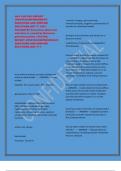Unit 3 NU 545| RECENT
UPDATE|COMPREHENSIVE steroids: Estrogen, glucocorticoids,
QUESTIONS AND VERIFIED mineralocorticoids, progestin, testosterone (all
SOLUTIONS |GET IT 100% steroids are cholesterol based)
ACCURATE!! Gonnorhea (Bacterial
infection) Is caused by Neisseria
derivatives of arachidonic acid (autocrine or
gonorrhoeaeUnit 3 NU 545|
paracrine action):
RECENT UPDATE|COMPREHENSIVE
QUESTIONS AND VERIFIED Leukotrienes, Prostacyclins, prostaglandins,
SOLUTIONS |GET IT 1 thromboxanes
How are water-soluble hormones transported?
- -----ANSWER---->Water-soluble hormones are
proteins that are polarized with a high
molecular weight. Because they cannot diffuse
across the lipid cell plasma membrane, they
must interact or bind with receptors in or on
the cell membrane to activate a second-
know which hormones are water-soluble and
messenger to mediate short-acting responses.
which are lipid-soluble - -----ANSWER---->water
soluble:
peptides- GH, insulin, leptin, PTH, prolactin How are lipid-soluble hormones transported? - -
----ANSWER---->Lipid-soluble hormones diffuse
freely across the cell and nuclear membrane
glycoproteins- FSH, LH, TSH and bind with cytosolic or nuclear receptors.
(can also bind with receptors in or on the
plasma membrane)
polypeptides: adrenocorticotropic hormone,
ADH, calcitonin, endorphins, glucagon,
hypothalamic hormones, lipotropins, know how protein hormones are transported in
melanocyte-stimulating hormone, oxytocin, the blood - -----ANSWER---->peptide or protein
somatostatin, thymosin, thyrotropin-releasing hormones are water-soluble and circulate in
hormone free (unbound) forms
amines: Epi, Norepi why do water soluble hormones have a short
half-life? - -----ANSWER---->because they are
catabolized by circulating enzymes. Remember
lipid soluble: they are unbound.
Thyroxine: T3 and T4
,How long can lipid-soluble hormones remain in How does oxytocin relate to the pituitary gland?
the blood? - -----ANSWER---->For hours to days. - -----ANSWER---->the posterior pituitary stores
They last longer in the blood because they are and secretes oxytocin.
bound to carrier/transport proteins.
Once synthesized, oxytocin is packaged in
secretory vesicles along with its neurophysin
and moved down the axons of the pituitary
only free hormones can do what? - -----
stalk to the pars nervosa for storage.
ANSWER---->initiate changes within a target cell
Release of oxytocin is mediated by what? - -----
How does the concentration of binding proteins
ANSWER---->cholinergic and adrenergic
affect the concentration of free hormones in
neurotransmitters. the major stimulus for
the plasma? - -----ANSWER---->because
release is glutamate.
equilibrium exists between the concentration of
free hormones and hormones bound to plasma
proteins
Where is oxytocin secreted and what are its
effects? - -----ANSWER---->it is secreted from
the posterior pituitary. Oxytocin is responsible
What are the two main functions of the target
for the contraction of the uterus and milk
cell hormone receptor? - -----ANSWER---->1. To
ejection in lactating women and may affect
recognize and bind with high affinity to their
sperm motility in men. Oxytocin is released in
particular hormones
response to suckling (oxytocin binds to
2. To initiate a signal to appropriate intracellular receptors on myoepithelial cells in the
effectors mammary tissue and cause contraction causing
milk expression or let down reflex) and
distention of the uterus (oxytocin stimulates
*when a hormone is released into the contractions with a positive feedback loop).
circulatory system, it is distributed throughout
the body, but only those cells with appropriate
hormone receptors for that hormone are Where is ADH secreted? - -----ANSWER---->ADH
affected. is produced in the hypothalmus and secreted by
the posterior pituitary. ADH and the posterior
pituitary regulate osmolality.
what is oxytocin? - -----ANSWER---->a
polypeptide hormone synthesized in the
supraoptic and paraventricular nuclei of the Where does ADH act? - -----ANSWER---->ADH
hypothalamus. Oxytocin is implicated in acts on vasopressin (V2) receptors of the renal
behavior responses, especially in women. tubular cells to increase their permeability,
Oxytocin plays a role in brain responsiveness to which leads to increased water absorption in
stressful stimuli, especially in the pregnant and the blood stream, increasing the concentration
postpartum states. of urine and reducing serum osmolality.
, what causes ADH to be secreted? - ----- What is the target tissue and action of
ANSWER---->when plasma osmolality increases, Thyrotropin-releasing hormone (TRH)? - -----
the osmoreceptors of the hypothalamus are ANSWER---->Anterior pituitary
stimulated- the rate of ADH secretion is
Stimulates release of TSH and Modulates
increased causing more water to be absorbed
prolactin secretion
by the kidneys- the plasma osmolality returns to
its set point (280 mOsm/kg)
What is the target tissue and action of
Gonadotropin-releasing hormone (GRH)? - -----
How does ADH effect electrolytes? - -----
ANSWER---->Anterior pituitary
ANSWER---->ADH does not directly effect
electrolytes but due to the dilutional effect of Stimulates release of follicle-stimulating
increasing water absorption, serum electrolytes hormone (FSH) and luteinizing hormone (LH).
may decrease
What is the target tissue and action of
How does the body detect volume loss in order Somatostatin? - -----ANSWER---->Anterior
to stimulate receptors to release ADH? - ----- pituitary
ANSWER---->Baroreceptors in the L Atrium,
carotid arteries, and aortic arch detect changes Inhibits release of growth hormone(GH) and
in intravascular volume. Once a volume loss of TSH
7-25% is detected, receptors are stimulated.
What is the target tissue and action of Growth
What can cause secretion of ADH? - ----- hormone-releasing hormone (GHRH)? - -----
ANSWER---->stress, trauma, pain, exercise, ANSWER---->Anterior pituitary
nausea, nicotine, exposure to heat, and drugs Stimulates release of GH
(morphine)
What is the target tissue and action of
when does ADH secretion decrease? - ----- Corticotropin-releasing hormone (CRH)? - -----
ANSWER---->when plasma osmolality ANSWER---->Anterior pituitary
decreases/returns to normal, intravascular
volume increases, with HTN, an increase in Stimulates release of adrenocorticotropic
estrogen, progesterone, angiotensin II, and hormone (ACTH) and B-endorphin
alcohol ingestion.
What is the target tissue and action of
How does ADH affect blood pressure? - ----- Substance P? - -----ANSWER---->Anterior
ANSWER---->ADH acts on vasopressin (V1) pituitary
receptors which cause vasoconstriction, - inhibits synthesis and release of ACTH
increasing blood pressure
Stimulates secretion of GH, FSH, LH, and
prolactin




